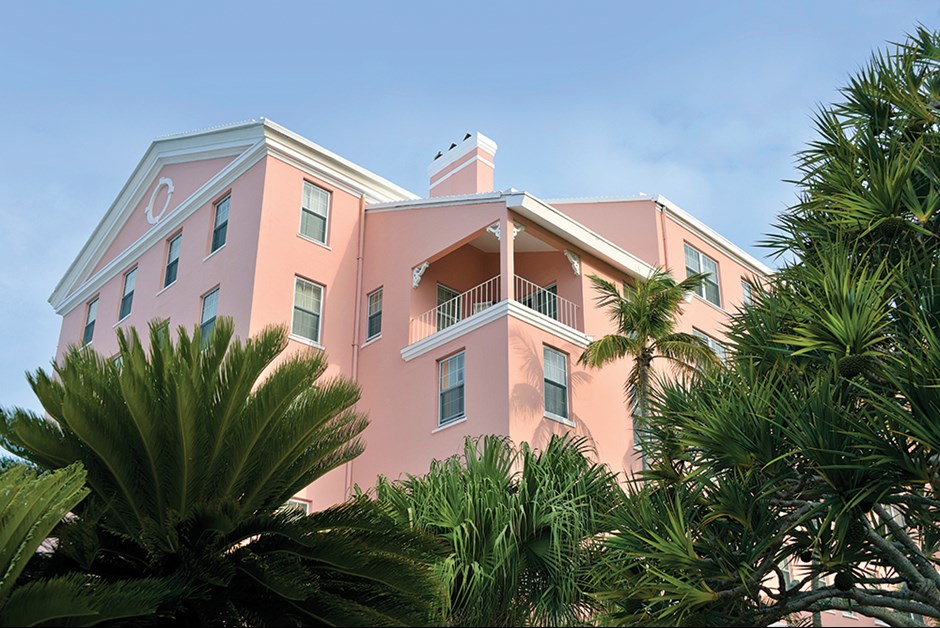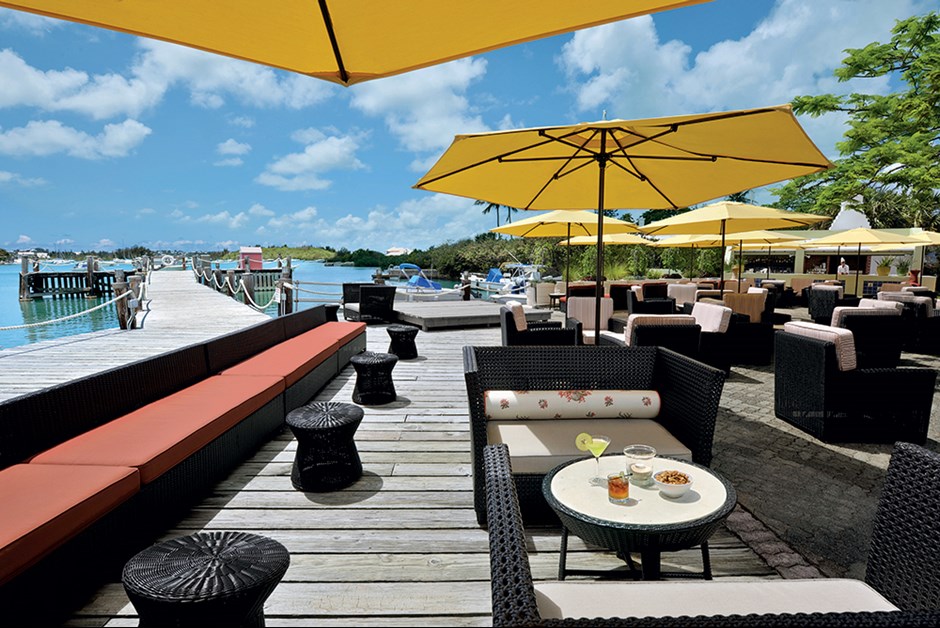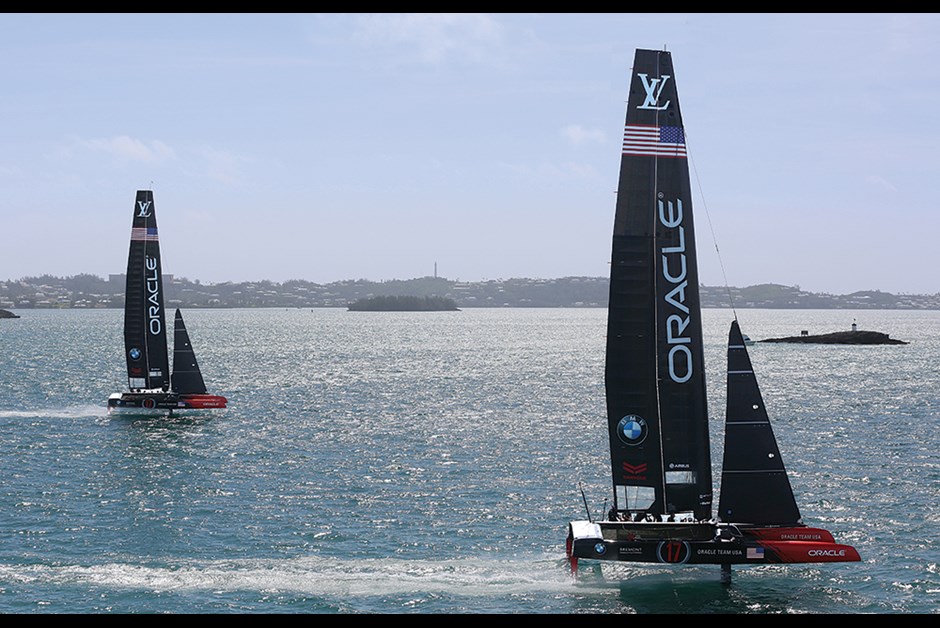Set to Sail
By Jody Robbins
Champagne-cork pops and peals of laughter ripple off the water. The sun is high in a cloudless sky and a warm sea breeze invites us to sail along, but we don’t move. The yachts in our fleet, at least a dozen strong, have cut their motors and stand at attention in the turquoise waters of Bermuda’s Great Sound. We’ve be-come stakes marking the racecourse for the oldest trophy in international sport.
I’m among hundreds of revelers taking in the America’s Cup qualifiers and we couldn’t be any closer to the action without getting wet. Bubbly in hand, I have a bobbing front-row seat on the racecourse, watching six teams do battle in the fastest sailboats in the world. The prize: points toward the America’s Cup finals, which will happen right here in June 2017.
Adrenaline pumps through my veins just watching the teams whiz around the course. That sense of exhilaration is palpable no matter where you find yourself on the island these days. Mere hours ago, while taking afternoon tea at the Jasmine Lounge in Fairmont Southampton, I had just tucked in to a second scone when Team France made its way to the restaurant balcony to conduct an outdoor workout – a rigorous combination of aerobics and balancing postures – in full view of the guests. Wherever I look, preparations are under way. The cup is a major coup for this island that owes its heritage to sailing.
Bermuda, the oldest British overseas territory, has been continuously inhabited since the Sea Venture, an English ship carrying settlers and supplies, ran aground here in 1609 on her maiden voyage from Plymouth to Jamestown, Virginia. Many locals can still trace their roots to the survivors of this wreck. In its founding century, islanders would also invent the Bermuda rig, a tall, triangular mainsail that more efficiently harnessed the power of the wind than its gaff-rig predecessor. Four hundred years later, it’s still used in 95 percent of sailing yachts.
Ironically, the reef system that sank the Sea Venture and caused hundreds of other historic wrecks is what acts as a shield around Great Sound, preventing choppiness and creating the flat, fast water that makes Bermuda one of the best sailing venues on the planet.
Given these endowments, bringing the pinnacle prize of international sailing to the island should have been a mathematical certainty. But this is a competition without the benefit of regularity. Unlike the Olympics, the competition has no set schedule or requirement to rotate venues. Only five nations have hosted the last 34 cups. And both the timing and location are determined in a “gentleman’s agreement” between a challenger and the defender.
The “Auld Mug,” as it’s known, is also one of the most difficult trophies to win. Fierce rivalries have developed since the inaugural race in 1851, when America, a purpose-built yacht commissioned by members of the New York Yacht Club, trumped the best of the British fleet. Only four countries – the US, Switzerland, New Zealand and Australia – have managed to take home the America’s Cup (named after the first victor), in spite of dozens vying for it.
All eyes are once again on the Americans, with Team USA defending their back-to-back victories in 2010 and 2013. A “three-peat” in 2017 won’t be easy, as this competition is as much a testament to boat design and management as it is to sailing prowess.
“Technical improvements, which we work on for years, account for 80 percent of the opportunity,” avows Grant Simmer, Team USA’s general manager and chief operating officer.
I catch up with Simmer on the northern barb of this fish-hook-shaped isle, at the Royal Naval Dockyard, now the headquarters of the 35th America’s Cup. Amid the 19th-century buildings, wharves and fortifications, Team USA has erected a dry-land base camp out of 40 shipping containers. A constant buzz is emitted from this nerve center as engineers and boat designers work feverishly on improved versions of the sailing vessels.
This isn’t your grandfather’s boat race – it’s pure action on the ocean. The wing-sailed catamaran racers use foils to lift the hull so it hovers over the ocean, moving at almost three times the speed of the prevailing wind. Over the years the race has been reduced from five hours out at sea to 25 minutes just offshore, making the America’s Cup more exciting and accessible, easily viewed from land.
It may be organized chaos behind the scenes, but it’s smooth sailing for fans. With a vibe akin to the Grand Prix, visitors groove with locals to live music along Front Street in the seaside capital of Hamilton, where handsome Victorian-era pastel buildings and bustling outdoor patios line the harbor, presided over by the regal Hamilton Princess & Beach Club, a Fairmont Managed Hotel. The street-party atmosphere is enhanced with pop-up restaurants, fireworks and plenty of rum-splashed cocktails. VIP hospitality is served up throughout the day inside Club AC, a swish marquee overflowing with Champagne, canapés and a festive Sperry-heeled crowd.
While the America’s Cup will take over next June, nautical opportunities abound in the lead-up. Visitors can start at the newly built 59-berth marina at the Hamilton Princess & Beach Club. Here, guests can hoist sail on a chartered yacht and get up close and personal with the teams in training. Sitting prominently along the harbor, the “Pink Palace,” as it’s affectionately referred to by guests, is the official host hotel for the festivities and the place to rub shoulders with the who’s who of the sailing world.
And while the entire island is polishing up for the Cup’s arrival, the Hamilton Princess has undergone its own $100-million top-to-bottom refresh. With public art laced throughout the property, it has also become an unexpected new art destination, featuring original works by Damien Hirst, Andy Warhol and even Nelson Mandela: modern masterpieces that juxtapose with the property’s historic architectural detail.
Generating an equal amount of buzz is Marcus’. The hotel’s new restaurant is the place to see and be seen. Situated in the former grand ballroom overlooking the Atlantic, it offers creative riffs on traditional Bermudian dishes by acclaimed New York-based chef Marcus Samuelsson.
Inside the airy, window-lit space, I dunk fish chowder croquettes into savory rum aioli. Samuelsson’s nod to a traditional Bermudian soup is fresh and inventive. The jerk pork belly topped with a quivering quail egg is also a winner, but after feasting upon vibrant flavors from the sea, I’m ready to dive back into it.
With snorkel gear and a gallon of Rum Swizzle (an intoxicating punch of rum, fruit juice, grenadine and bitters) below deck, I board the Aristocrat, a 55-foot catamaran. In Bermuda, everything has a distinct hue: from the national cocktail to the tailored shorts sported by businessmen to the powdery pink sand found at Fairmont Southampton’s south-shore beachfront.
Cutting through the very same jewel-toned waters of the America’s Cup racecourse, my group and I set sail for the northwest side of the Royal Naval Dockyard. Palm trees and ice-cream-colored houses sweep by as we pick up speed, cruising between five and 10 knots.
Mindful of the reefs, our sober-faced crew expertly hugs the coastline. These treacherous corals have led to the world’s greatest concentration of shipwrecks, making the island a haven for scuba divers. Even so, you needn’t plunge very deep to have a vivid underwater experience.
We don snorkeling gear and leap off the bow into a kaleidoscope of fish. The visibility is incredible and I feel worlds away from the technology and training of the competition. While the America’s Cup has helped Bermuda regain her sea legs, I’m reminded there is much to enjoy out here, smack dab in the middle of the Atlantic.
Schools of curious technicolor wrasse, silver sea bream and yellow-fringed angel fish swirl around me as I float over massive coral reefs.
After losing track of time in these underwater gardens, I slip back onto the sailboat refreshed and ready for the Rum Swizzle quickly pressed into my hands. The boat’s captain boards right behind me, grasping a spiny lobster he plucked off the reef with his bare hands. We are impressed, setting down our drinks to give him a round of applause. “Deep diving is something you learn to do here as a kid,” he says with a shrug.
Back at the Hamilton Princess after our snorkel, I gaze through floor-to-ceiling windows as the sun sinks ever so slowly into the ocean, its final rays splashing tangerine across the sky. In the near distance I spot an intriguing vessel, her commanding sails billowing in the breeze. She is the Spirit of Bermuda, a replica of a Royal Navy sloop of war, created to instill an awareness of the island’s maritime heritage. It serves as another reminder that, no matter where you are in Bermuda, you are never far from life at sea.
Concierge
STAY
The 131-year-old Hamilton Princess & Beach Club (pictured) is the official host hotel of the America’s Cup. A recent ambitious renovation revealed a new selection of suites, a newly assembled modern art collection, a 2,150-square-foot gym and Exhale Spa.
thehamiltonprincess.com
Perched majestically atop Bermuda’s southern shores, the bougainvillea-clad Fairmont Southampton resort ensures guests can partake in both beach and city pleasures. A yacht shuttles guests to Albuoy’s Point in the center of Hamilton. fairmont.com/southampton-bermuda
DINE
Nestled dockside on Jew’s Bay, the Waterlot Inn serves fine steaks and chops in its award-winning dining room. Afterwards, head to the outdoor loungers at The Dock at the Waterlot to sip handcrafted cocktails and groove to the DJ’s beats.
With just-out-of-the-ocean fish roasting on the wood-fired grill, it’s no wonder Marcus’ at the Hamilton Princess & Beach Club is the island’s latest hot spot. One of the few oceanfront dining establishments in Bermuda, this celebrity-chef outpost serves up island hospitality and local flavors.
DO
Trek through Bermuda’s one and only jungle, swim in an underground cave and barrel off cliffs into an aquamarine mangrove pond on a tour with Hidden Gems guiding service.
bermudahiddengems.com
Landlubbers can cycle down the “Old Rattle and Shake,” Bermuda’s short-lived rail line. Bike tours with Fantasea Diving & Watersports stop at points of interest, including old British forts and the world’s smallest drawbridge.
fantasea.bm


